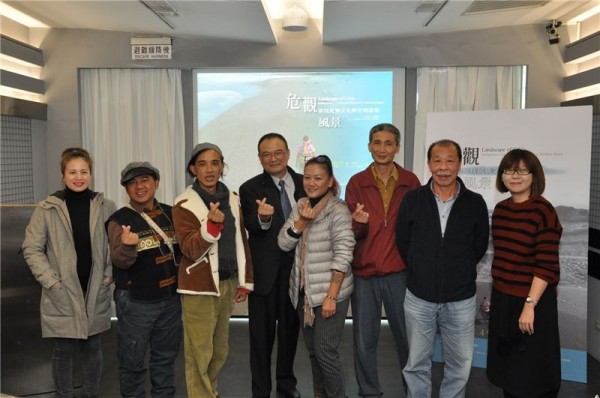The National Taiwan Museum of Fine Arts will host an exhibition exploring issues related to the lives, space, and culture of indigenous peoples in modern society through shifting landscapes from Jan. 21 through April 9.
Hosted by Director Hsiao Tsung-huang (蕭宗煌) of NTMoFA on Jan. 20, the opening ceremony was joined by participating artists Guan Xiao-rong (關曉榮), Wong Yau-pong (王有邦), Etan Pavavalung (伊誕‧巴瓦瓦隆), Chien-wei Pa-Li (見維‧巴里), Idas Losin (宜德思‧盧信), and Chang En-man (張恩滿).
Titled "Landscape of Crisis — Indigenous Cultures and Dispositif of Modern Space,” the crisis here refers to the self-awareness one develops while viewing landscape-themed art. The three-month exhibition will highlight the cultural geography and political issues that are faced by aboriginal peoples today.
Director Hsiao noted that the exhibition seeks to bridge the gap between the Han people and Taiwan's aboriginal groups, as well as fuse the traditional and the contemporary by inviting aboriginal and non-aboriginal artists to jointly participate in the exhibition.
Featured artists will provide the exhibition with various creations that focus on history, events, and landscapes, and present their self-reflective thoughts and cultural practices from different perspectives to promote dialogue, added Hsiao.
Curator Huang Shu-ping (黃舒屏) also noted that landscapes are closely connected to the history of migration and geopolitics of Ilha Formosa. The exhibition will highlight how geographic factors contributed to the traditional development of the island's environment, culture, space, and economy.
"Orchid Island, 1987” will showcase a series of photographic works recorded by Guan when he visited the island off Taitung coast. Published in "Ren Jian” magazine, the photographs documented the anti-nuclear waste-dumping movement headed by the Yami people, an ethnic group native to Orchid Island, and reflected the problems of spatial politics.
"Morakot, 2009” will offer insights on the impact of natural disasters upon the culture and space of indigenous peoples. Typhoon Morakot was one of the most devastating natural disasters to strike the island in decades. It forced several aboriginal tribes to relocate, and posed new challenges to their cultures, territories, and living space within the context of Taiwan's modern society.
Etan, whose mountain-dwelling tribe had to relocate to prefabricated housing units at the mountain base in the wake of Morakot, reconstructs Paiwan culture and reflects his concerns over the future of the tribe through wooden works of carved lines and patterns (紋砌刻畫).
Beinan artist Pa-Li will also showcase a series of works created after the disaster, incorporating driftwood and ink paintings to reflect the environmental issues of land development and urban development in relations to traditional aboriginal culture.
In addition, the Morakot section will present the development of Rukai settlement Kucapungane after experiencing spatial politics and natural havoc. The combination of wooden installations, maps, and photographic works were created by Wang in collaboration with HippocampusPerformance Troupe (海馬迴藝工隊).
"Mei Li Wan (Beautiful Bay), 2012,” a controversial resort development project in the aboriginal land of Taitung in 2003, will reflect the capitalist treatment of natural landscapes and the environmental issues that arise from aggressive land development.
The Mei Li Wan section will feature the "I see” series by Idas, a Truku artist who has created human figures wearing glasses that reflect aboriginal perspectives concerning commercial land development in their ancestral land of eastern Taiwan.
"Heavy as a Feather (重如鴻毛),” a large kite with audio components created by Chang and her Amis community of Fulafulangan, will also present the stories and songs associated with legendary figure Ngayaw as a way to represent their tribe's cultural practices.
The exhibition will not only present these artists' viewpoints and the changing environment, society, and traditions, but re-scrutinize the crises and challenges faced by aboriginal groups in present day by monitoring contemporary landscape conditions as well.
'Landscape of Crisis'
- Date: Jan. 21 - April 7, 2017
- Venue: National Taiwan Museum of Fine Arts
- Address: No. 2 Wuquan West Road Section 1, West District, Taichung City, Taiwan (ROC)
- Website: www.ntmofa.gov.tw
Related Content
